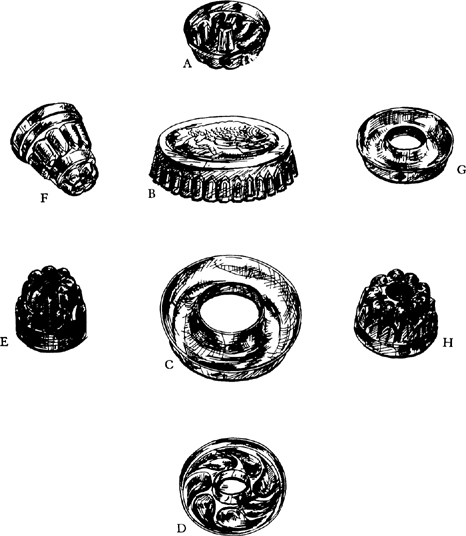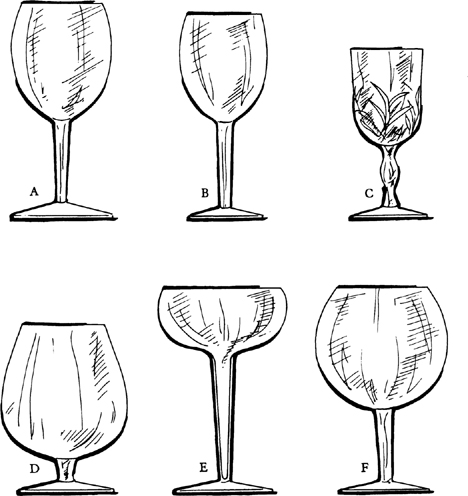Mastering the Art of French Cooking, Volume 2 (226 page)
Read Mastering the Art of French Cooking, Volume 2 Online
Authors: Julia Child

SOUFFLÉ DISHES AND BAKING DISHES
When you are instructed to “bake the dessert in an 8-cup cylindrical mold or dish, such as a charlotte, 4 inches deep,” A, D, and E are the dishes to use. The French charlotte molds (A and D) are the most useful baking dishes you can have in your kitchen, because you can bake in them, mold in them, caramelize them, heat them on top of the stove as well as in the oven, and you can serve from a napkin-wrapped charlotte mold. Be sure you buy the all-purpose type in tin-washed metal,
tôle étamée;
there are some models in flimsy aluminum that are good only for cold desserts. Useful sizes are the 6- and 8-cup models, although 3-cup, 4-cup, and very large sizes may fill some occasional needs. The American flameproof ceramic baking and soufflé dish (E) is excellent too, and a little deeper than the charlottes. French ovenproof white soufflé dishes (B and C) are attractive for baking and serving; for soufflés, tie a paper collar around them to hold the puff, as illustrated in Volume I, page 162.
PÂTÉ MOLDS
Although you can make do with other methods, the traditional hinged mold for
pâtés
is comforting to own, decorative to look at, and will produce the beautiful finished product
illustrated
. These are of
tôle étamée
, tin-washed metal, and come in many sizes, shapes, and patterns. A 2-quart (2-liter) size is the most useful when you are buying only one. If you do not know how much a particular mold will hold, set it on a large piece of heavy foil or brown paper, fill with dried beans or rice, remove mold, and measure the beans or rice.
MISCELLANEOUS SMALL MOLDS
Eggs form themselves most happily in aspic when the mold is oval; the
moules á dariole ovales
, B and C, hold ½ cup and come with plain or fancy bottoms.
Babas
are baked in tiny charlottes, E and F, or the
dariole ronde
, A; these hold slightly over ⅓ cup, and are useful also for individual servings of aspic, and for small soufflés and custards. The miniature fluted mold, D, is for fancy aspics.
MOLDS FOR BAKING, FOR ASPICS, AND FOR FROZEN DESSERTS
Although the
Kougloff
and
trois frères
molds (A and D) are designed for cakes, and the ice-cream mold (E and F) for
bombes glacées
, all of the models pictured here are useful for aspics, and all, with the obvious exception of the fish (B), would do for frozen desserts and Bavarian creams. Use a simple pattern for frozen desserts (C and G); beware of too complicated a design or you may have terrible difficulties unmolding; the pattern in H is about as far as you can go. Although more modern materials are available, we like
tôle étamée
, tin-washed metal, for both baking and aspics because it seasons well—meaning it seems to present few sticking problems. Tin-lined copper for aspics is pretty to look at if you do not mind the initial expense and subsequent cleaning.
WINE GLASSES
If space is a problem, you need only one type of wine glass for Bordeaux, Burgundy, Rhine wine, Champagne, or Chianti—the tulip-shaped glass (A) that holds ¾ to 1 cup; fill it slightly less than half full to give room for swirling and sniffing. Equally serviceable is the shorter glass (B). If you are going to serve both a red and a white wine at a meal, use a larger glass (A) for the red wine in proportion to the one for the white wine (B); the white wine glass is usually placed on the outside. All of these are inexpensive and should be available in any wine shop or department store, as well as in all the restaurant and hotel supply stores. For prestigious red Bordeaux and Burgundies, the large-bowled glass (F) is amusing; a normal serving of 3 ounces looks small in it but develops its fullest bouquet. If you like to see all the champagne bubbles, hollow-stemmed crystal (E) is what to look for, although some connoisseurs sniff at wide-mouthed glasses for that noble brew. Cut-crystal sherry glasses (C) will start off any gathering in an elegant manner, and the brandy snifter (D) will release after-dinner esters.






